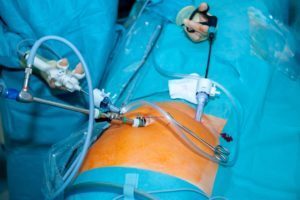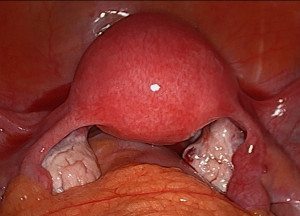Laparoscopy is sometimes referred to as “keyhole surgery”, where instruments are placed into the abdomen and pelvis through small incisions 5-10mm in diameter.
Laparoscopy enables the gynaecologist to view the entire abdominal cavity and pelvis under magnification. This allows the gynaecologist to diagnose and treat diseases of the ovaries, uterus and Fallopian tubes. Gynaecological oncologists are also experienced in using laparoscopy to perform surgery on the pelvic side walls, allowing them to remove pelvic lymph nodes and other tissues which may be affected by gynaecological malignancies. The magnified views offered by the laparoscope may allow even subtle disease and lesions to be seen, which may otherwise have been missed in traditional open surgery.
A laparoscope is a long thin instrument which allows light to pass in and out of the abdominal cavity. An extremely bright light is conducted via a fibre optic cable to the laparoscope, and the light is reflected back from the intra-abdominal organs and captured by the laparoscope, which in turn feeds the image to a ultra high definition camera. A live video is then displayed for the surgeon and the surgical assistant, giving them a direct image of what’s happening inside the body.
Advantages of Laparoscopic Surgery
The advantages of keyhole surgery include:
- Faster recovery and return to normal work and activities
- Less pain after surgery
- Shorter hospitalisation
- Better cosmetic outcome, with smaller scars
- Better visualisation of disease by the surgeon (allowing more accurate diagnosis and precise treatment).
Click on the video below to find out what gynaecological laparoscopy is all about:
Dr Amy Tang specialises in performing laparoscopy for both benign and malignant gynaecological conditions. She performs total laparoscopic hysterectomy (removal of the uterus), laparoscopic salpingo-oophorectomy (removal of the ovaries and tubes), laparoscopic lymphadenectomy (removal of lymph nodes) and laparoscopic resection of endometriosis.
Common benign indications for Total Laparoscopic Hysterectomy include:
- Heavy periods (menorrhagia)
- Adenomyosis
- Fibroids
- Prolapse
Click here to learn more about laparoscopic hysterectomy.
For further information, arrange an appointment to discuss your condition with Dr Tang.











